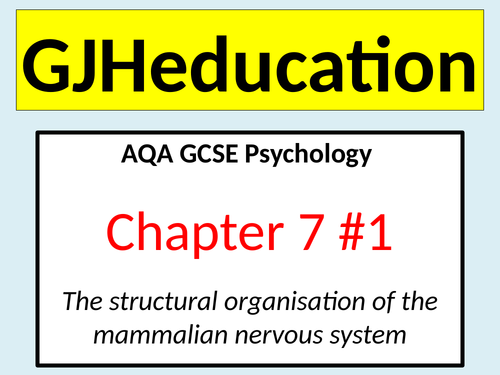


This lesson focuses on the organisation of the nervous system into the CNS and the several divisions of the PNS. The PowerPoint and accompanying resource are part of the 1st lesson in a series of 17 lessons that cover the details of the brain and neuropsychology topic of the AQA GCSE Psychology specification.
This lesson has been designed to act as an introduction to the topic to allow students to understand how the brain and spinal cord (as part of the CNS) and the SNS and ANS (as part of the PNS) fit into the organisation of the system. The functions of each part are briefly introduced to give an understanding that can then be built upon in future lessons in the topic. The students will learn that the main part of the brain is the cerebrum and that this organ is divided into hemispheres. They’ll learn that the brain is connected to the other part of the CNS, the spinal cord, by the brain stem, and that these nerves are responsible for conducting impulses between the brain and the rest of the body. The differences between the somatic and autonomic nervous systems are introduced before a worksheet task challenges the students to recognise which responses are brought about by the SNS and which by the ANS.
This topic of the brain and neuropsychology has proved particularly difficult for the students in recent years, so I have taken time to analyse the lesson sequencing. There’s a lot of content to absorb and to understand before moving onto the next part, so I’ve tried to ensure that cross topics links and prior knowledge checks run throughout the lessons. I have organised the lessons to run through the biology content first before moving onto the psychology parts as shown by the 17 lessons below:
#1 Organisation of the nervous system
#2 The structure and function of the cerebral lobes
#3 The cerebellum
#4 The structure and function of the sensory and motor neurones
#5 The relay neurones
#6 Synaptic transmission
#7 Excitation and inhibition at the synapse
#8 The somatic nervous system
#9 The autonomic nervous system
#10 The fight or flight response
#11 James-Lange theory of emotion
#12 James-Lange theory of emotion part 2
#13 Penfield’s study of the interpretative index
#14 Hebb’s theory of learning and neuronal growth
#15 An introduction to neuropsychology
#16 Brain scanning techniques
#17 Tulving’s gold memory study
Something went wrong, please try again later.
This resource hasn't been reviewed yet
To ensure quality for our reviews, only customers who have downloaded this resource can review it
Report this resourceto let us know if it violates our terms and conditions.
Our customer service team will review your report and will be in touch.